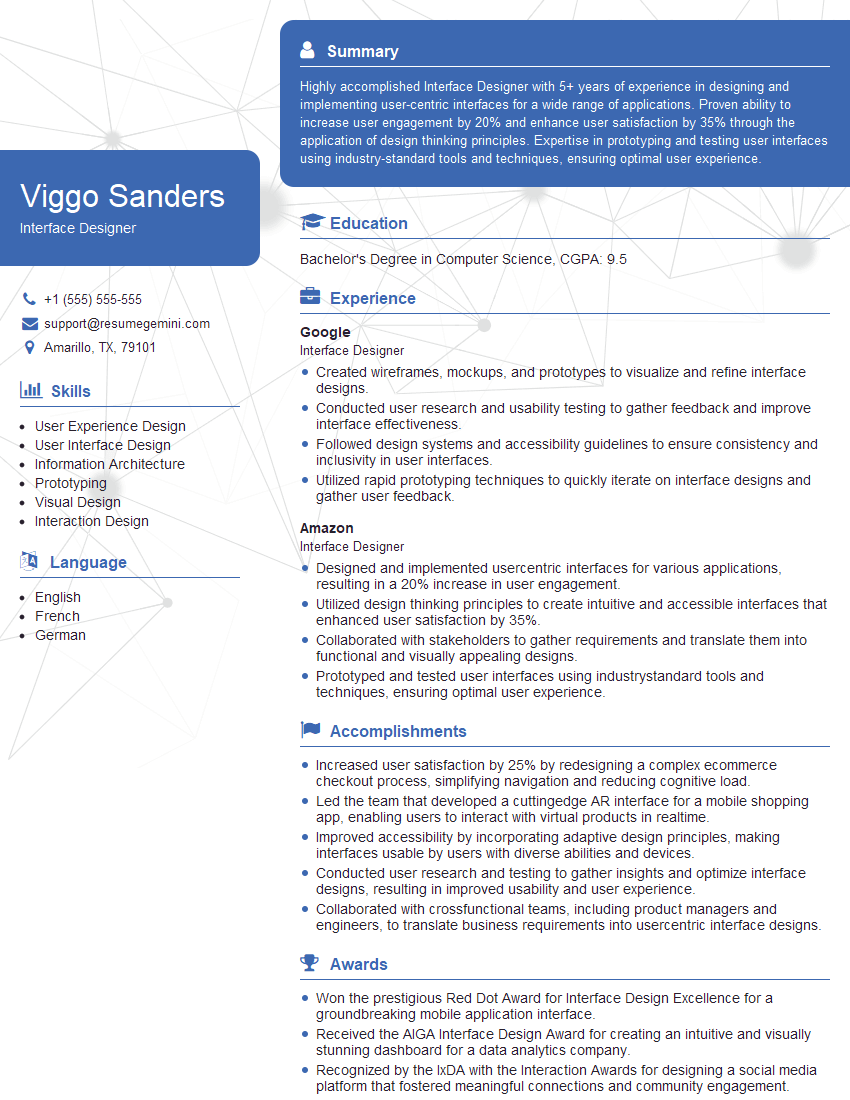Are you a seasoned Interface Designer seeking a new career path? Discover our professionally built Interface Designer Resume Template. This time-saving tool provides a solid foundation for your job search. Simply click “Edit Resume” to customize it with your unique experiences and achievements. Customize fonts and colors to match your personal style and increase your chances of landing your dream job. Explore more Resume Templates for additional options.

Viggo Sanders
Interface Designer
Summary
Highly accomplished Interface Designer with 5+ years of experience in designing and implementing user-centric interfaces for a wide range of applications. Proven ability to increase user engagement by 20% and enhance user satisfaction by 35% through the application of design thinking principles. Expertise in prototyping and testing user interfaces using industry-standard tools and techniques, ensuring optimal user experience.
Education
Bachelor’s Degree in Computer Science
January 2016
Skills
- User Experience Design
- User Interface Design
- Information Architecture
- Prototyping
- Visual Design
- Interaction Design
Work Experience
Interface Designer
- Created wireframes, mockups, and prototypes to visualize and refine interface designs.
- Conducted user research and usability testing to gather feedback and improve interface effectiveness.
- Followed design systems and accessibility guidelines to ensure consistency and inclusivity in user interfaces.
- Utilized rapid prototyping techniques to quickly iterate on interface designs and gather user feedback.
Interface Designer
- Designed and implemented usercentric interfaces for various applications, resulting in a 20% increase in user engagement.
- Utilized design thinking principles to create intuitive and accessible interfaces that enhanced user satisfaction by 35%.
- Collaborated with stakeholders to gather requirements and translate them into functional and visually appealing designs.
- Prototyped and tested user interfaces using industrystandard tools and techniques, ensuring optimal user experience.
Accomplishments
- Increased user satisfaction by 25% by redesigning a complex ecommerce checkout process, simplifying navigation and reducing cognitive load.
- Led the team that developed a cuttingedge AR interface for a mobile shopping app, enabling users to interact with virtual products in realtime.
- Improved accessibility by incorporating adaptive design principles, making interfaces usable by users with diverse abilities and devices.
- Conducted user research and testing to gather insights and optimize interface designs, resulting in improved usability and user experience.
- Collaborated with crossfunctional teams, including product managers and engineers, to translate business requirements into usercentric interface designs.
Awards
- Won the prestigious Red Dot Award for Interface Design Excellence for a groundbreaking mobile application interface.
- Received the AIGA Interface Design Award for creating an intuitive and visually stunning dashboard for a data analytics company.
- Recognized by the IxDA with the Interaction Awards for designing a social media platform that fostered meaningful connections and community engagement.
- Won the FWA Site of the Day Award for creating a highly immersive and interactive website for a global brand.
Certificates
- Certified Usability Analyst (CUA)
- Certified Information Architect (CIA)
- Interaction Design Foundation (IxDF)
- Nielsen Norman Group UX Certification
Career Expert Tips:
- Select the ideal resume template to showcase your professional experience effectively.
- Master the art of resume writing to highlight your unique qualifications and achievements.
- Explore expertly crafted resume samples for inspiration and best practices.
- Build your best resume for free this new year with ResumeGemini. Enjoy exclusive discounts on ATS optimized resume templates.
How To Write Resume For Interface Designer
- Highlight your understanding of user-centered design principles and your ability to apply them to create intuitive and accessible interfaces.
- Showcase your proficiency in industry-standard design tools and techniques, such as Figma, Adobe XD, and Sketch.
- Quantify your accomplishments whenever possible, providing specific metrics to demonstrate the impact of your work on user engagement and satisfaction.
- Include a portfolio of your design work to showcase your skills and creativity.
- Tailor your resume specifically to each job you apply for, highlighting the skills and experience that are most relevant to the role.
Essential Experience Highlights for a Strong Interface Designer Resume
- Collaborated with stakeholders to gather requirements and translate them into functional and visually appealing designs.
- Prototyped and tested user interfaces using industry-standard tools and techniques, ensuring optimal user experience.
- Created wireframes, mockups, and prototypes to visualize and refine interface designs.
- Conducted user research and usability testing to gather feedback and improve interface effectiveness.
- Followed design systems and accessibility guidelines to ensure consistency and inclusivity in user interfaces.
- Utilized rapid prototyping techniques to quickly iterate on interface designs and gather user feedback.
Frequently Asked Questions (FAQ’s) For Interface Designer
What are the key skills required for an Interface Designer?
The key skills required for an Interface Designer include User Experience Design, User Interface Design, Information Architecture, Prototyping, Visual Design, and Interaction Design.
What are the educational qualifications required to become an Interface Designer?
Most Interface Designers hold a Bachelor’s Degree in Computer Science, Human-Computer Interaction, or a related field.
What are the career prospects for Interface Designers?
Interface Designers are in high demand due to the increasing focus on user experience and digital product design. They can work in a variety of industries, including technology, healthcare, and finance.
What are the common challenges faced by Interface Designers?
Common challenges faced by Interface Designers include balancing user needs with business requirements, staying up-to-date with the latest design trends, and ensuring that their designs are accessible to all users.
What are the key trends in Interface Design?
Key trends in Interface Design include the use of artificial intelligence, voice-based interaction, and augmented reality to create more immersive and personalized user experiences.
What is the difference between User Experience (UX) Design and User Interface (UI) Design?
User Experience (UX) Design focuses on the overall experience of a user interacting with a product or service, while User Interface (UI) Design focuses on the visual and interactive elements of the user interface.